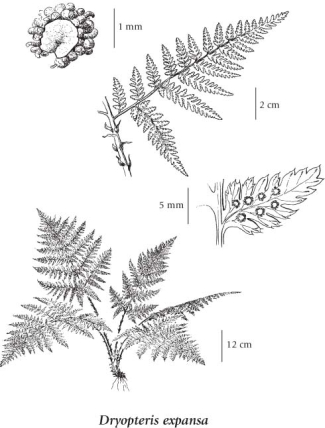Dryopteris expansa (C. Presl) Fraser-Jenkins & Jermy
spiny wood fern (spreading wood fern; spreading woodfern)
Dryopteridaceae (Wood Fern family)
Introduction to Vascular Plants
spiny wood fern (spreading wood fern; spreading woodfern)
Dryopteridaceae (Wood Fern family)
Introduction to Vascular Plants
Species Information
General:
Deciduous perennial arising in vase-like clusters or singly.
Leaves:
Triangular to oblong-triangular, 20-70 cm long, 10-60 cm wide, sparsely glandular on rachis and lower side of pinnae, 2- to 3-pinnate, the lowest pinnae longer than the upper ones, leaf outlines triangular.
Illustration

If more than one illustration is available for a species (e.g., separate illustrations were provided for two subspecies) then links to the separate images will be provided below. Note that individual subspecies or varietal illustrations are not always available.
Illustration Source: The Illustrated Flora of British Columbia
Ecology
Ecological Framework for Dryopteris expansa
The table below shows the species-specific information calculated from
original data (BEC database) provided by the BC Ministry of Forests and Range.
(Updated August, 2013)
The table below shows the species-specific information calculated from
original data (BEC database) provided by the BC Ministry of Forests and Range.
(Updated August, 2013)
| Site Information |
Value / Class |
||
|
Avg |
Min |
Max |
|
| Elevation
(metres) |
737 | 0 | 2750 |
| Slope
Gradient (%) |
23 | 0 | 410 |
|
Aspect (degrees) |
350 | 0 | 360 |
| Soil
Moisture Regime (SMR) [0 - very xeric; 4 - mesic; 8 - hydric] |
4 | 0 | 8 |
| Modal
Nutrient Regime
Class |
D | ||
| #
of field plots species was recorded in: |
5889 | ||
| Modal
BEC Zone Class |
CWH | ||
|
All BEC Zones (# of stations/zone) species was recorded in |
BAFA(1), BWBS(36), CDF(72), CMA(1), CWH(2243), ESSF(1067), ICH(1419), IDF(59), MH(59), MS(79), SBPS(3), SBS(645) | ||
|
Source:
Klinkenberg 2013
|
|||
Habitat and Range
Mesic to wet forests, forest margins and scree slopes from the lowland and steppe to subalpine zones; common in BC; circumpolar, N to AK, YT and NT, E to NF, S to MI, WI, MN, CO, ID and CA; Eurasia.Status Information
Synonyms
Synonyms and Alternate Names:
Dryopteris assimilis S. Walker
Dryopteris dilatata auct. non (Hoffm.) A. Gray
Dryopteris dilatata subsp. americana (Fisch.) HultΘn
Dryopteris spinulosa subsp. assimilis
Dryopteris spinulosa var. dilatata auct. non (Hoffm.) Underw.